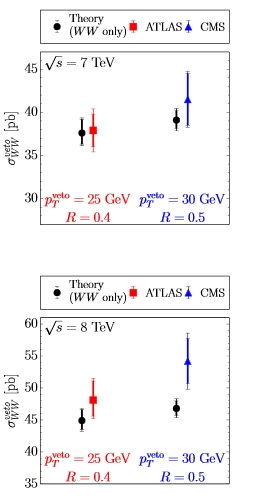Those departures of WW cross sections from theory predictions are not extreme - one could well explain them away as a statistical fluctuation, or the combination of a fluctuation with some common shortcoming of the two measurements; but they are interesting, as it would be exactly the kind of effect one would observe if a not-too-strange realization of Supersymmetry were what Nature has chosen for our Universe.
Now Preirit Jaiswal and Takemichi Okui, from Florida State university, argue that the calculations of cross sections of WW pairs needed to compare to LHC data have to account for the experimental selections, which include a "jet veto". That is, both ATLAS and CMS to enhance their WW signals and reduce contaminations from competing processes (like top quark pair production) impose to the data a cut on the presence of hard jets in the events.
A jet is a stream of particles emitted when a energetic quark or gluon is kicked off the hard collision region. The parton (that's what we call a hadron constituent, i.e. either a quark or a gluon) "dresses up" as a stream of particles, which collectively share the total energy and momentum of their common parent. Hadronic jets are a quite common observation in proton-proton collisions -it is quite hard to observe events with no jets! But indeed, requiring the lack of energetic jets in WW events is a very useful tool to enhance the signal to noise ratio. So where is the problem ?
The problem is that ATLAS and CMS resort to Monte Carlo simulations of WW production with a parton shower modeling to see how many WW+0 jets events would pass their selections. These are quite well-studied and advanced tools, but they might fail to produce accurate estimates for the corner of phase space that is used to compare data and predictions.
In the theoretical calculation of the process one has to deal with two different energy scales: the scale of production of the WW pair, and the scale at which a parton is radiated off by the hard subprocess. If you want to account for the presence of this parton, which becomes an observable jet, and calculate only the rate of WW pairs which do not feature any such jets, you need to operate some complex calculations called "resummation" of large logarithms of the ratio of the two energy scales.
The authors employ a technique called SCET, for "soft collinear effective theory", which is way too complex to explain here (and to tell the truth I can't explain something I do not fully understand myself!). However, their paper is quite detailed and, I must say, exceptionally clear, so if you are willing to give a try at understanding how these calculations are done, the paper is a good read for you. Let us see what the authors conclude for the cross section of jet-vetoed WW boson production processes.
 The comparison of the authors' resummed NNLL+NLO calculations to ATLAS and CMS experimental results for the WW cross sections is shown in the graphs on the right; the top graph is for the 7-TeV measurements and the bottom one for the 8-TeV one. There is overall excellent agreement, with only one of the four results being just over one sigma away! The 2- and 3-sigma effects reported by the collaborations are no longer present. I believe this is a very good example of how two "excesses" seen by different experiments do not count as twice as much evidence for something new: indeed, both results may be affected by one and the same systematic error source.
The comparison of the authors' resummed NNLL+NLO calculations to ATLAS and CMS experimental results for the WW cross sections is shown in the graphs on the right; the top graph is for the 7-TeV measurements and the bottom one for the 8-TeV one. There is overall excellent agreement, with only one of the four results being just over one sigma away! The 2- and 3-sigma effects reported by the collaborations are no longer present. I believe this is a very good example of how two "excesses" seen by different experiments do not count as twice as much evidence for something new: indeed, both results may be affected by one and the same systematic error source. I believe that if one has to choose between the hypothesis that the excesses are due to Supersymmetry and the hypothesis that the jet veto introduces a large systematic uncertainty, it would be hard to pick the first. So, sorry SUSY enthusiasts - let's keep searching.



Comments